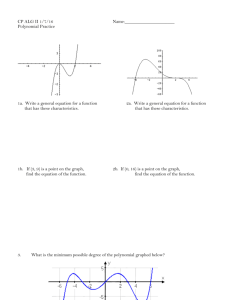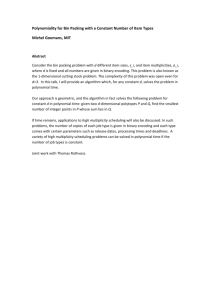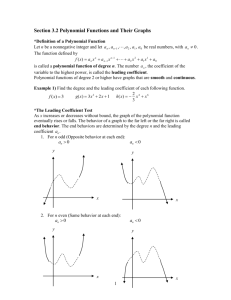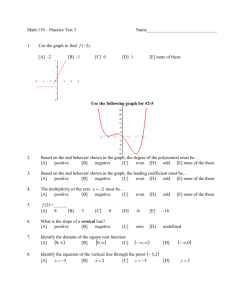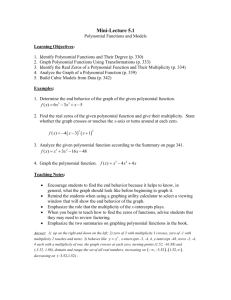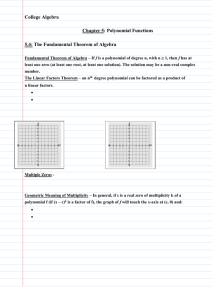Polynomial
advertisement
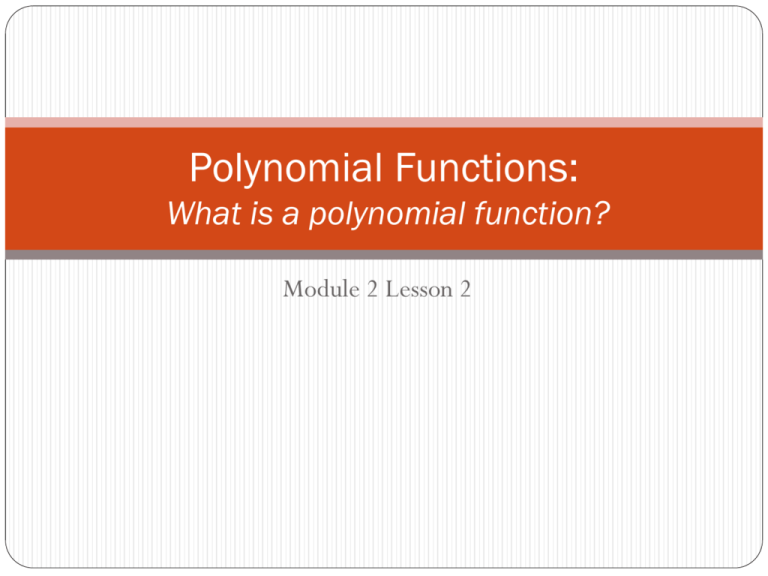
Polynomial Functions: What is a polynomial function? Module 2 Lesson 2 What is a Polynomial? A polynomial is expression in the form: f ( x) an x an 1 x n n 1 ... ax c where The coefficients (the a values) are real numbers The exponents (the n values) are whole numbers (positive integers) The domain is All Real Numbers. Examples Polynomials NOT Polynomials y 5x 2 x 4 y 3x 4 x 1 3 6 3 f ( x) x 7 x x 4 5 f ( x) 3 x 3 3 Exponents are not positive integers! Ways to define polynomials By Degree The largest degree of the function is the degree of the polynomial By the number of terms. Count the number of terms in the expression. State the degree of the following polynomial functions 𝑓 𝑥 = 5𝑥 + 2𝑥 2 − 6𝑥 3 + 3 3 ℎ 𝑥 = 2𝑥 3 (4𝑥 5 + 3𝑥) 8 𝑔 𝑥 = 2𝑥 5 − 4𝑥 3 + 𝑥 − 2 5 𝑘 𝑥 = 4𝑥 3 + 6𝑥 11 − 𝑥 10 + 𝑥 12 12 Defining using number of terms Monomial: A number, a variable or the product of a number and one or more variables. Binomial: A polynomial with exactly two terms. Trinomial: A polynomial with exactly three terms. Polynomial: A monomial or a sum of monomials. For four or more terms, we just call it a polynomial. Classify the polynomials by degree and number of terms Polynomial Degree 5 Zero Constant Monomial b. 2x 4 First Linear Binomial c. 3x 2 x Second Quadratic Binomial Third Cubic Trinomial Fourth Quartic a. . d. x3 4 x 2 1 e. 3x4 - 4x3 + 6x2 - 7 f. 8x7 - 7x - 9 Seventh Classify by degree Septic or Heptic Classify by number of terms Polynomial Trinomial Solving Polynomial Equations To solve a polynomial equation you will find the x – intercepts.You find x-intercepts by letting y = 0 and then using the Zero Product Property (just like when you were solving quadratics!). Intercepts can be referred to as solutions, roots, or zeros. The maximum number of solutions a polynomial can have is limited by the degree of the polynomial! If f(r) = 0 and r is a real number, then r is a real zero of the function and…. … r is an x-intercept of the graph of the function. … (x – r) is a factor of the function. … r is a solution to the function f(x) = 0 Multiplicities Sometimes a solution will appear more than once. This solution has a multiplicity. To find a Multiplicity Count the number of times a factor (m) of a function is repeated. Multiplicities appearing an Even Number of times The graph of the function touches the x-axis but does not cross it. Multiplicities appearing an Odd Number of times The graph of the function crosses the x-axis. Identify the zeros and their multiplicity 3 is a zero with a multiplicity of 1. Graph crosses the x-axis at x = 3 -2 is a zero with a multiplicity of 3. Graph crosses the x-axis at x = -2. -4 is a zero with a multiplicity of 1. Graph crosses the x-axis at x = -4. 7 is a zero with a multiplicity of 2. Graph touches the x-axis at x = 7. -1 is a zero with a multiplicity of 1. Graph crosses the x-axis at x = -1. 4 is a zero with a multiplicity of 1. Graph crosses the x-axis at x = 4 2 is a zero with a multiplicity of 2. Graph touches the x-axis at x = 2 End Behavior of a Polynomial You can predict what directions the ends of the graph are going based on the sign of the leading coefficient and the degree of the polynomial. If 𝑓 𝑥 = 𝑎𝑥 𝑛 and n is even, then both ends will approach +. If 𝑓 𝑥 = −𝑎𝑥 𝑛 and n is even, then both ends will approach – . If 𝑓 𝑥 = 𝑎𝑥 𝑛 and n is odd, then as x – , 𝑓 𝑥 – and as x , 𝑓 𝑥 . If 𝑓 𝑥 = −𝑎𝑥 𝑛 and n is odd, then as x – , 𝑓 𝑥 and as x , 𝑓 𝑥 –. End Behavior, con’t 𝑓 𝑥 = 𝑎𝑥 𝑛 and n is even 𝑓 𝑥 = −𝑎𝑥 𝑛 and n is even 𝑓 𝑥 = 𝑎𝑥 𝑛 and n is odd 𝑓 𝑥 = −𝑎𝑥 𝑛 and n is odd Time to put it all together! For the following polynomial: Define by number of terms and degree, State number of possible solutions, Find zeros and state multiplicities, Describe multiplicities, Describe the end behavior, and Sketch graph. f ( x) ( x 1)( x 2) 2 f ( x) ( x 1)( x 2) 2 Define by number of terms and degree and state number of possible solutions To find the degree and the number of terms, we will need to distribute. f ( x) ( x 1)( x 2)( x 2) ( x 1)( x 2 4 x 4) x3 4 x 2 4 x x 2 4 x 4 x 3 3x 2 4 So we have a third degree, or cubic, trinomial. This trinomial will have a maximum of 3 unique solutions. f ( x) ( x 1)( x 2) 2 • Find zeros and state multiplicities and describe multiplicities. 0 ( x 1)( x 2) 2 0 x 1 0 x2 x 1 x 2 The solutions to this polynomial are x = 1 and x = -2. The zero at x =1 has a multiplicity of 1. The graph will cross the x-axis at 1. The zero at x = -2 has a multiplicity of 2 and will touch the x-axis. f ( x) ( x 1)( x 2) 2 x 3 3x 2 4 Describe the end behavior and Sketch graph. Since n = 3, an odd number, we know that the end behavior will be split- one side will be going up and the other side will be going down. As a = +1, the graph will being going up from left to right. So the left side of the graph is pointing down and the right side of the graph is pointing up. Sketch the Graph 1. Plot zeros 2. Choose a point in between zeros to help find turning point. Let x = -1 y = (-2)(-1+2)2 = -2 3. Find y-intercept Let x = 0 y = (-1)(2)2 = -4 4. Plot the other points. 5. Use end behavior and intercepts to graph.


